Bird rescuers may have to feed a baby bird. And with a little patience you can learn how to teach a baby bird to eat on its own. Find out what type of food to feed baby birds at each stage of their development and learn how to wean a fledgling away from hand feeding by following this guide.
When do baby birds start eating on their own?
The exact age at which a baby bird begins to explore its surroundings and eat on its own depends on the species, but the majority of songbirds like weavers, hummingbirds, swallows, woodpeckers, and other altricial species transition to independence at roughly two weeks old.
Hatchings and nestlings are weak, hence if you know where their nest is, put them back if you can. If you can’t replace the little one at its original nesting site or the birdie clad with only a feather or two has a clear injury, you will have to learn how to teach the baby bird to eat on its own. Feeding as often as two or three times an hour in the first few hours of its life is crucial.
What should you feed an abandoned baby bird?
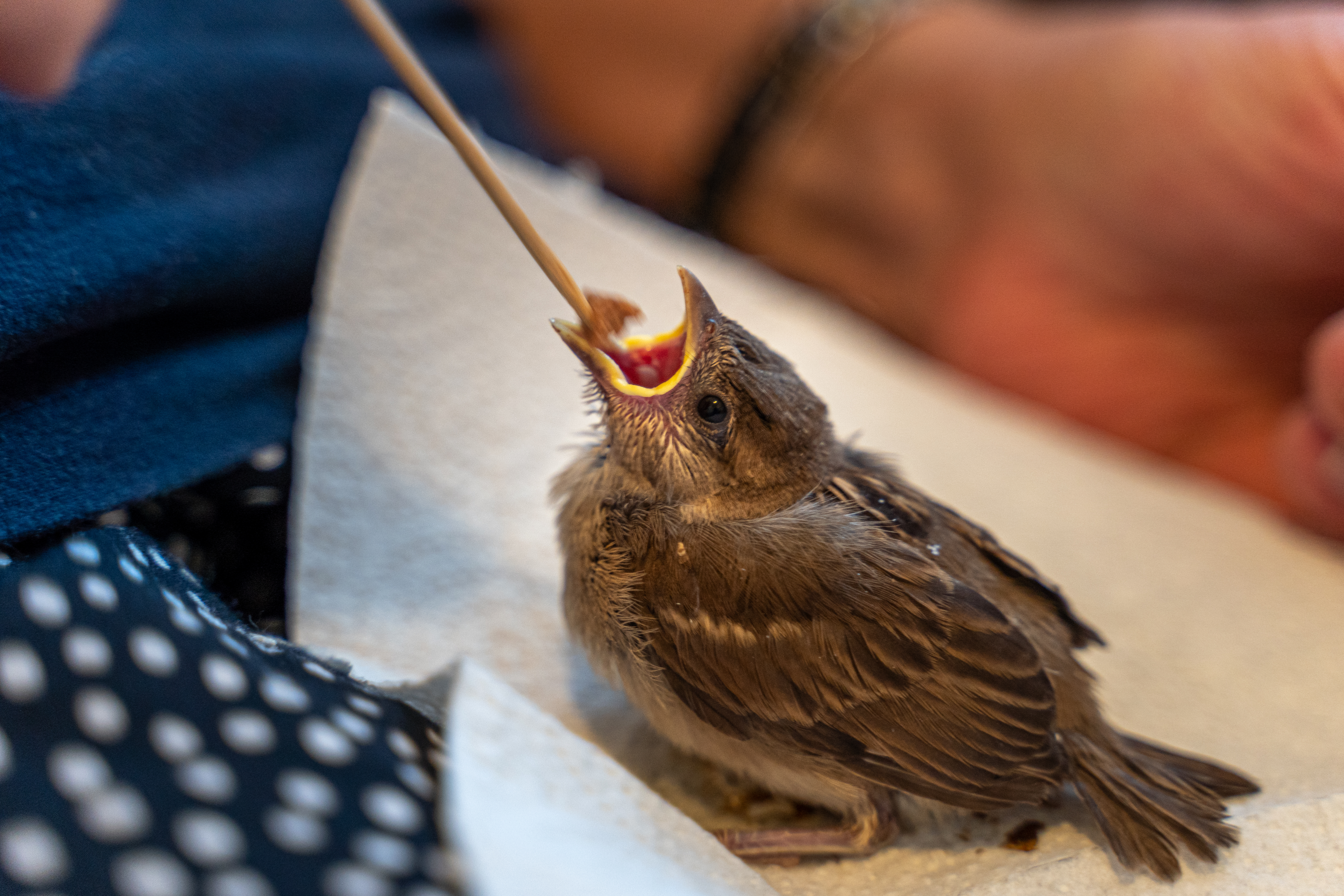
Omnivorous species, including most songbirds like jays, thrushes, woodpeckers, robins, starlings, and weavers, eat a mixed diet consisting of protein in the form of worms and insects combined with fruit, grains, vegetables, and seeds. However, seeds will only become a common food type at the fledgling stage and should never be fed earlier.
Make sure to soak a nestling’s food well before feeding. Baby bird food in formula form, is the best hand-rearing staple. When this is not available, crush up some insects (mealworms are a great choice), mix them with a little unsweetened baby cereal and soak well.
What to feed a baby bird without feathers
A baby bird without feathers, or a couple of pin feathers in formation, is a nestling. Nestlings need to eat every forty-five minutes to an hour.
What to feed the nestling depends on whether it’s an omnivore, herbivore, or carnivore.
The top choice for balanced nutrition is a reputable brand of baby bird food. Don’t trust unknown offerings, as they typically supply little or no proper sustenance for a nestling. Specialised baby bird formula of any type will always be better than a homemade solution if it’s available.
Unfortunately, finding a nestling displaced from its parents is an emergency situation. An in-between feeding session may be needed before a trip to the pet shop can be made. Feeding during the first few hours of a nestling’s life is crucial to healthy physical development.
Can baby birds eat mealworms?
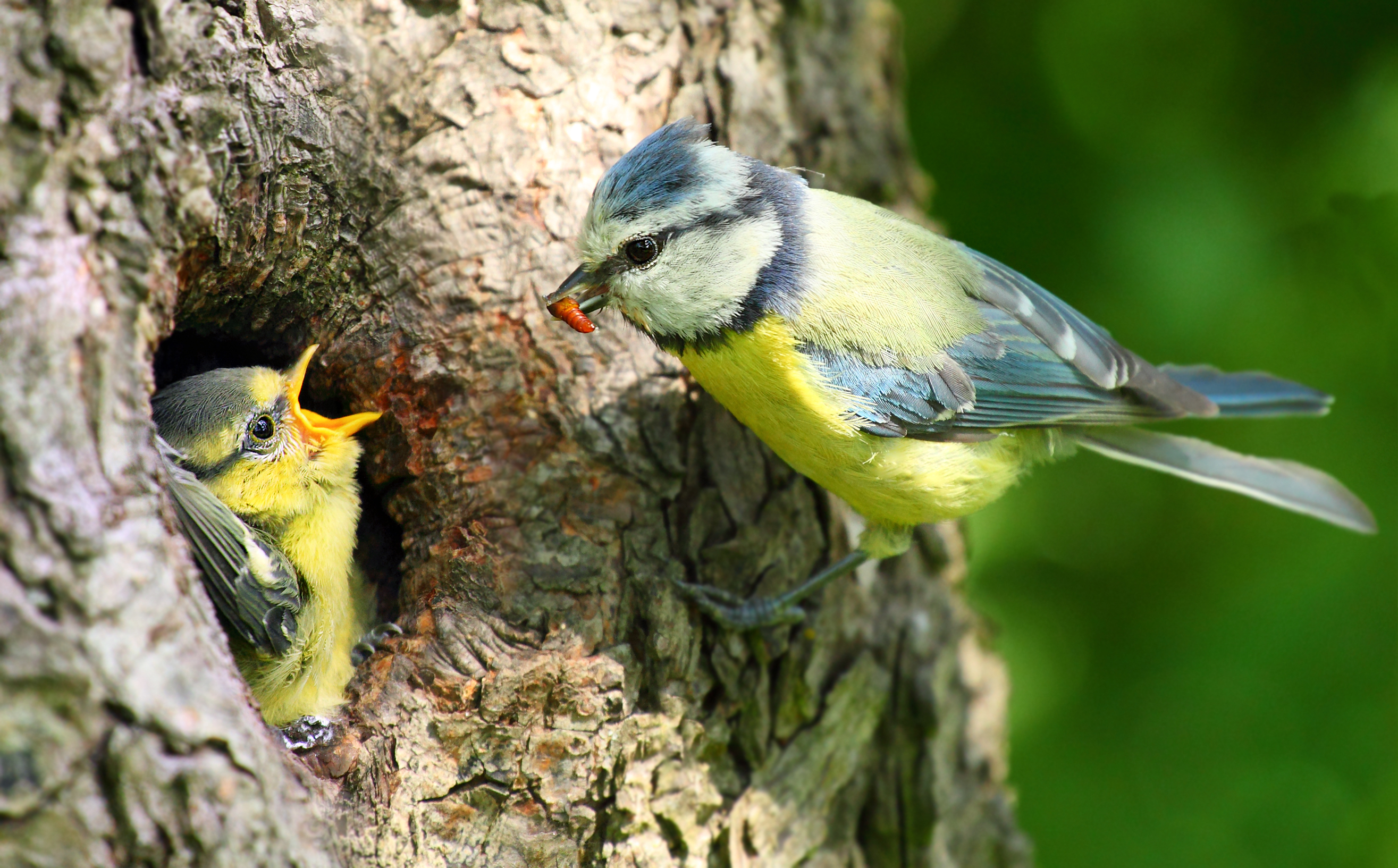
Mealworms are an excellent high-protein form of nutrition to add to a balanced diet in a schedule of regular feeding. You can start feeding live mealworms to nestlings and fledglings from five days old. However, hatchlings, nestlings, and the youngest of fledglings need mealworms squashed into a mushy liquid mixed with their diet.
Dried mealworms are a suitable, healthy substitute that is higher in fat than live ones. Soak and mash them into a pulp.
Although mealworms make great baby bird food, birds require a balanced diet. We recommend a diverse range of foods that mimic what they would normally eat in the wild. Do not feed a bird mealworm alone, or it can lead to adverse health complications like fatty liver disease.
How do you make baby bird food?
A mixture of scrambled egg yolk and your choice of baby cereal supplies reliably good nutrition. However, omnivores will need to eat insects as well. Even though birds can consume a large variety of insects, including, but not limited to crickets, grasshoppers, and all types of worms, getting large insects soft enough for a baby bird to ingest easily without posing a choking hazard can prove difficult.
Dried or live mealworms readily available at most pet shops are the safest, healthiest, and easiest to feed birds. Feed the baby bird a solution of egg yolk and baby food, perhaps combining it with fresh oats milk. Alternate this mix with live or soaked dried mealworms. Otherwise, make a homemade baby bird food solution by blending egg yolk, baby bird formula or oats milk, and pulped mealworms.
What can you feed a baby bird?
The solution above offers balanced nutrition for most songbirds. However, one can also resort to feeding baby birds soaked and softened dog or cat food, soaked cat or dog biscuits, or powdered ground birdseed mixed into a watery solution.
Combine these with scrambled egg or with the solution above. At this point place a seed dispenser in their habitat and they should start eating seeds on their own. Small seeds like grass and hemp seed are safe for almost all species to eat. Crush large seeds (pumpkin and butternut are good) small enough so it won’t get stuck in the bird’s beak.
What not to feed a baby bird
- Do not feed a baby bird milk other than oat milk or diluted soy milk for human babies.
- Do not feed baby birds whole or split seeds until they’re fledglings.
- Do not feed a baby bird random beetles and insects. They can be dangerous. The wrong insect could choke or poison a baby bird. Unknown bugs are bad.
Stick to safe food sources that you’d find in a pet shop.
Make sure the food source’s consistency is appropriate to the feeding age. Baby birds don’t need water. Once the bird is a fledgling, a drip water feeder or bath (or both) should be supplied, beak type dependent.
- Don’t feed baby birds anything off your plate until they’re fully grown and until you’re completely certain that the snack isn’t hazardous.
- Avoid bread at all costs, resorting to the tiniest of pieces as a treat if you must and only when they’re well into their fledgling stage.
Whole grains are healthier than white bread. Bread has no calories that birds can metabolize, leaving them feeling full while lacking the basic nutrition they need to survive. In the wild, a small bird who fills up on bread can die overnight due to not being able to sustain its basic body heat through burning calories.
Finally, refrain from changing a baby bird’s basic diet too much during the first few weeks of development. Stick to one baby bird food formula with pre-decided snacks or a homemade basic baby bird food solution and supplementary foods. Keep it simple and samey to help digestion. You don’t want the bird’s metabolism to slow and affect development.
How to feed a baby bird?
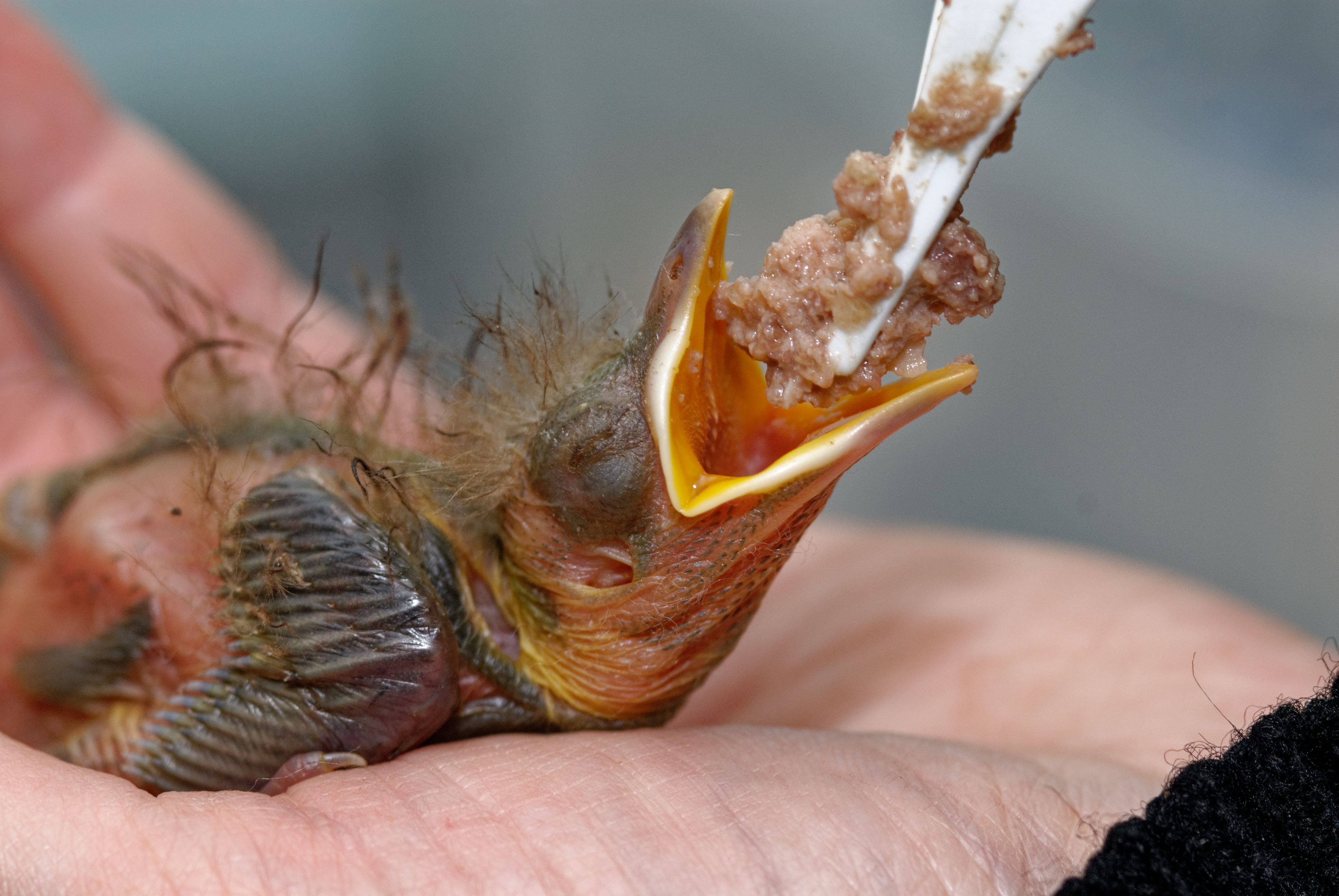
Before learning how to teach a baby bird to eat on its own, you’re going to have to learn the appropriate ways to feed it yourself. Food should be at room temperature for optimal digestion. Cold food slows digestion and can cause digestive issues in very young birds.
For the very young, the food should be the consistency of soup. Always use distilled or purified water to eliminate any risk of bacteria. As a general rule of thumb, any nestling is typically older than one or two days. This equates to a food mixture containing 70% to 75% liquid which is then thickened as the bird grows older.
Never store food. Always prepare it fresh.
Baby bird feeding technique
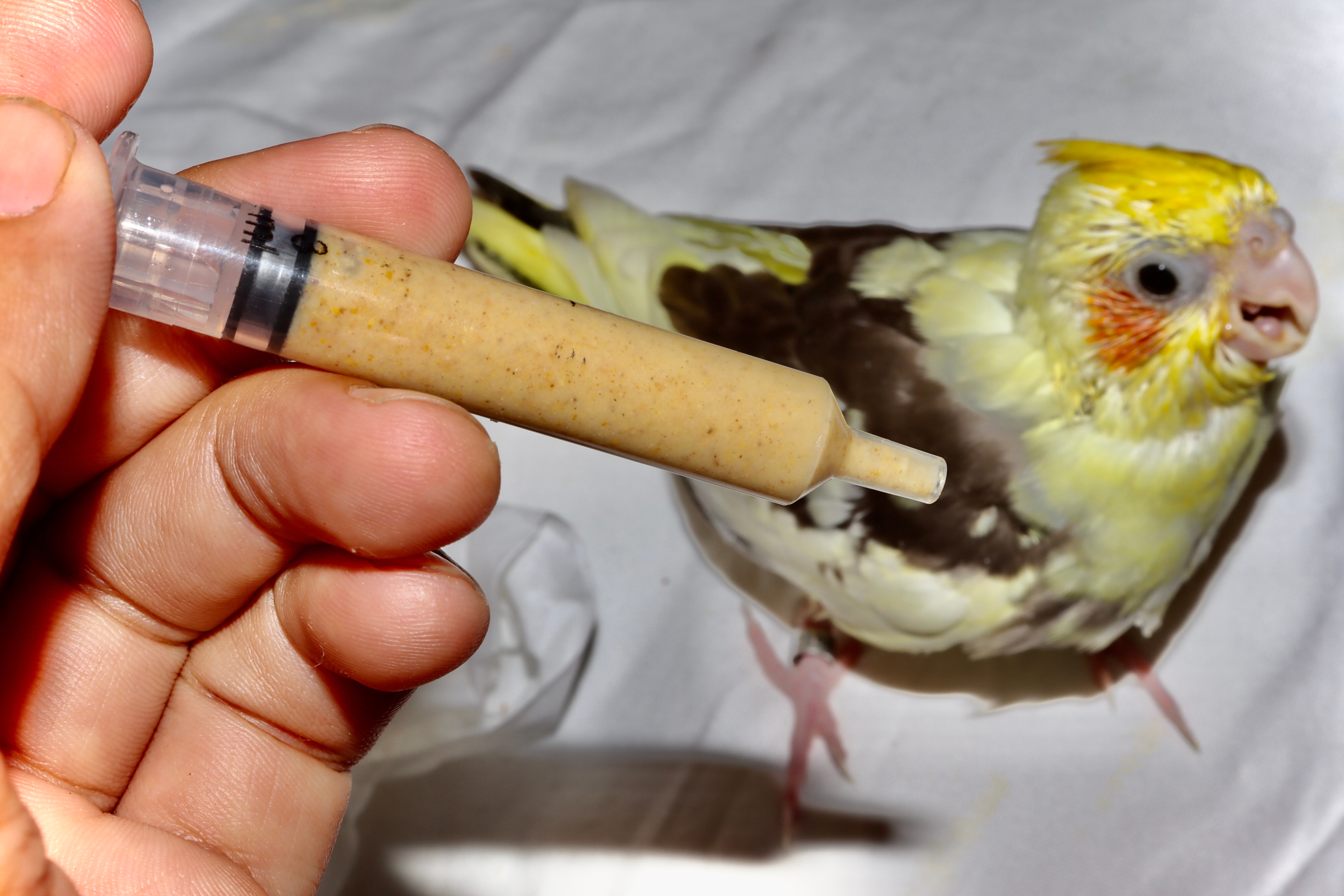
There are several reliable feeding tools for baby birds. A syringe being the best. Don’t underestimate how much you’re feeding at a time. Feed drop by drop only. Otherwise, fold a miniscule scoop just big enough for your bird’s beak out of card, hard paper or stiff plastic if you don’t have a syringe handy. Just make sure the edges are smooth, not sharp. Don’t use tweezers at any age. Their hardness can damage the bird’s beak.
Fill the syringe or spoon with as much food as you need for the feeding. Place the outlet or mouth of the spoon before the baby bird’s beak, coaxing it to open its mouth. Make sure the bird doesn’t choke by touching its beak with the syringe until it opens wide to take the food. The little one will almost always let you know when he or she is full. Don’t overfeed and never force a bird’s beak open to feed it.
How to Feed hatchlings
The youngest of hatchlings have a tiny crop. Don’t feed a baby bird until it is more than twelve hours. Always feed very young nestlings and hatchlings from the vessel serving as a nest. Don’t carry the bird around unnecessarily. A baby bird’s first feeding should be a single drop of water followed by another drop of water roughly an hour later.
Do not feed too often, or the hatchling will aspirate and die due to having an overfull crop. When the baby bird is excreting properly, feed at two-hour intervals for one week. Don’t ever miss a feeding session.
One to two-week-old nestling
After one week, alternate between two and three-hour feeding intervals and keep the food solution thin. From two weeks old, feeding can pause from midnight but must resume at exactly six AM.
Two to three-week-old fledgling
Feel free to begin taking the baby bird out of its nesting area. Place the little one on a soft, comfortable surface that prevents heat loss, such as a towel. Before feeding, make the baby formula thicker by approximately 25%. Feed every three to four hours. Start with three to four drops and make sure the baby bird’s crop doesn’t overfill.
Three to four-week-old fledgling
Make the formula about 25% thicker again. Introduce semi-whole foods like halved dried or live mealworms or a different type of seed. Switch feeding to four-hour intervals while keeping a close eye on the nestling’s crop to gauge fullness and feeding quantity.
Five to six-week-old fledgling
Hand-feed twice a day at 6 am and 6 pm. Add an additional food source that the bird can eat on its own. Whole foods like unsoaked, solid mealworms are ideal for hand feeding. Pellets or seeds suited to the species are also recommended. Caregivers are advised to devise a balanced diet and stick to it.
Seven-week-old bird
From seven weeks old, start introducing your young bird to pelleted food without hand-feeding, as well as either fresh fruits and vegetables or protein-like meat and seafood if they’re carnivorous. Transfer the bird to a substantially larger cage with several feeding trays and toys.
Ensure that you’re supplying at least 30% of the bird’s diet in moist food types, such as fresh vegetables and fruit
How to wean a bird from hand feeding?
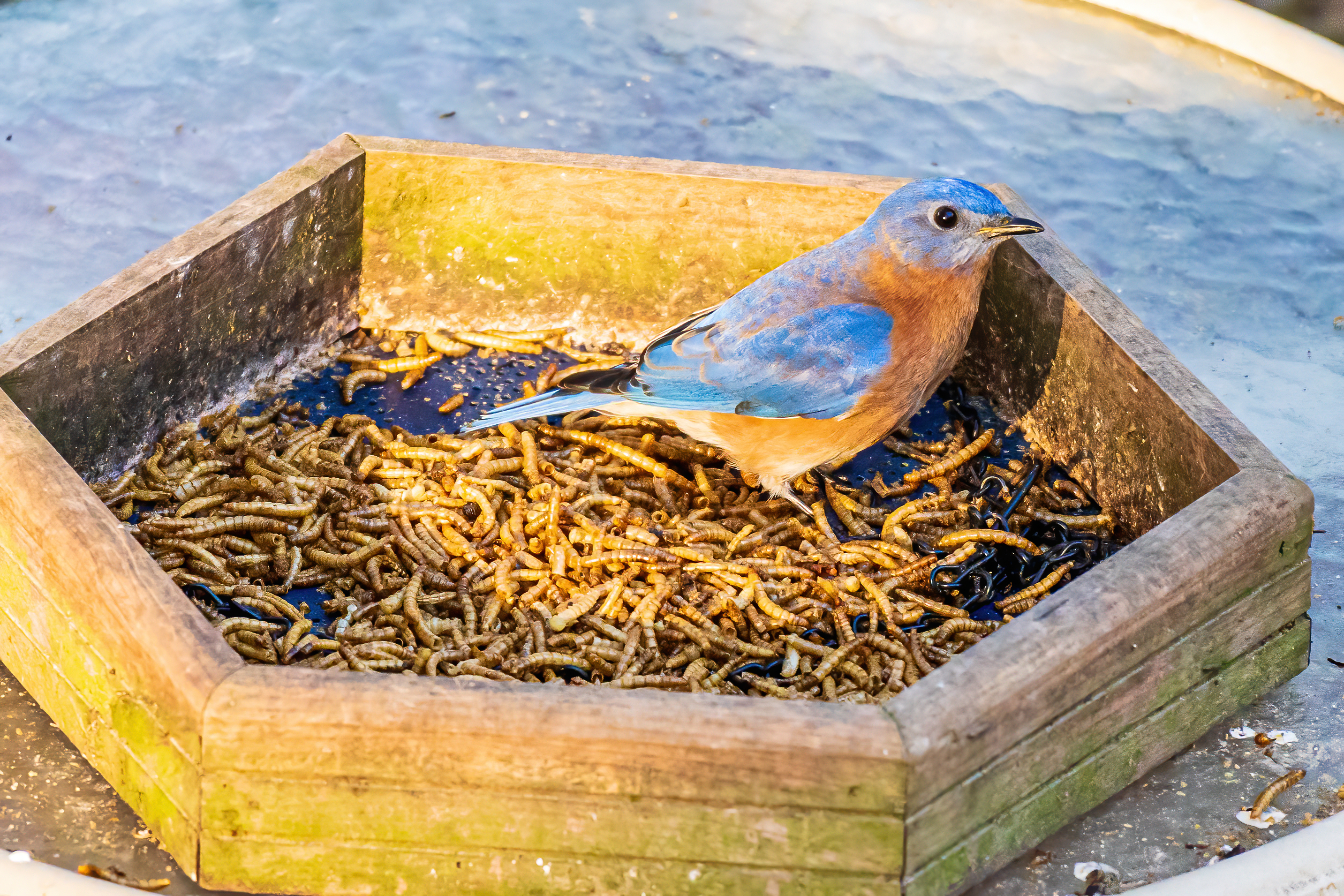
Weaning is the last step in how to teach a baby bird to eat on its own. This stage typically begins at eight weeks old but never sooner than seven. It is vitally important to only hand-feed once a day if necessary while constantly observing the bird’s crop to determine fullness. We suggest feeling the crop lightly to make sure the bird is eating if you’re not there to keep tabs on its habits throughout the day.
It is quite normal for a young bird to lose a little weight while weaning. If a baby bird is not weaned away from handfeeding it may only eat properly if it is fed by hand. If the bird keeps crying out for food and won’t eat on its own, the rescuer will have to carry on feeding, while switching the diet to something more nutritious.
Can a fledgling eat on its own?
By the time a baby bird has grown to become a fledgling, it is completely capable of eating independently. This doesn’t mean that the young bird necessarily will. A hand-raised bird will have picked up strong feeding habits. Another older bird in the house while weaning often helps a hand-reared young one to learn how to eat on its own by copying its elder.
Until then you may need to know how to teach a baby bird to eat on its own. Do not ignore a bird that cries out for food even after weaning. There could be a multitude of reasons ranging from simply being spoiled to malnutrition because of an underlying biological fault. It is best to check with a wildlife rehabilitator or an avian vet.
This can be lifesaving for many birds.
Final thoughts
In the wild a fledgling may begin to eat on its own at three to four weeks. When you know how to teach a baby bird to eat on its own, it will soon be ready to go back into the wild.
If you found a fledgling for example, a hand-reared baby bird will be eating most of its meals on its own from five to six weeks old while weaning away from handfeeding completely by seven to eight weeks.
Even though most birds start weaning at around fifteen days and are done at between eight to nine weeks at the latest, do not stop feeding by hand if the young bird refuses to eat on its own. Weaning can become a prolonged period.
Never allow your birdie’s health to suffer because it is attached to being fed.
And it will soon be time for the bird to learn to fly, as I found out and wrote in another article
FAQs
At what age can a baby bird start learning to eat on its own?
Baby birds typically start learning to eat on their own when they reach the age of 3 to 4 weeks. At this stage, they begin to develop the ability to pick up and manipulate food with their beaks.
What are some signs that a baby bird is ready to transition to independent feeding?
Signs that a baby bird is ready to eat on its own include increased activity, curiosity about food, and the ability to hold and peck at small pieces of food. Additionally, fledgling birds may show interest in foraging and exploring their surroundings.
How can I encourage a baby bird to eat independently?
To encourage a baby bird to eat independently, provide a variety of appropriate foods in small, manageable pieces. Gradually introduce the bird to different textures and types of food, and allow it to experiment and develop its natural feeding instincts.
What types of food are suitable for teaching a baby bird to eat on its own?
Soft and easily chewable foods are suitable for teaching a baby bird to eat on its own. These may include small pieces of fruits, vegetables, and soft insects. Ensure the food is appropriately sized for the bird’s beak and easy for it to handle.
Should I monitor the baby bird during its initial attempts at independent feeding?
Yes, it’s important to monitor the baby bird during its initial attempts at independent feeding. Keep a close eye to ensure it is eating sufficiently and offer support if needed. Be patient and provide a nurturing environment as the bird develops its feeding skills.
Why not Join Us
If you enjoyed this article, we would like to offer you two gifts – our Starter Pack of 4 James King’s books and our Weekly Digest, which you can receive by email.

